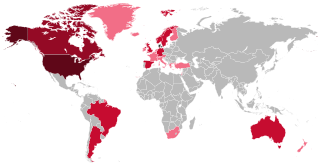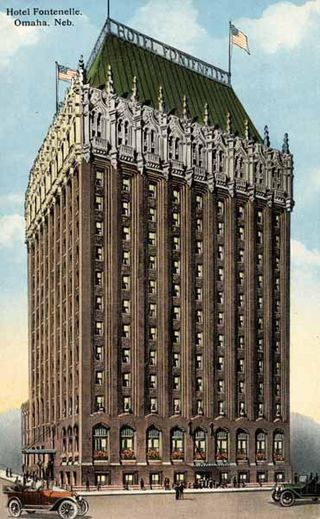The Danish people in Omaha, Nebraska, were a predominant ethnic group in the city in the 1920s, and were notable for that compared to other cities across the United States. [1] Omaha, as well as its neighbor, Council Bluffs, had "major colonies of Danes for many years." [2]
According to the definitive 1882 History of the State of Nebraska, the first Danes in Nebraska arrived at Florence with the Mormons in the 1840s. [3]
A Danish language newspaper called Den Danske Pioneer was founded in Omaha in 1872. 75 percent of its subscribers were Danish farmers in the United States. In 1882, the Danish Brotherhood in America, a fraternity, was founded in Omaha. In 2010, it counts about 8,000 members. [4]
A legacy of the continued influence of Danes in Omaha is the Danish Vennelyst Park, a private facility owned and operated by the Danish American Society of Omaha. [5] The park held Denmark's Constitution Day celebrations annually for many decades. [6] In 2016, the former Danish Brotherhood in America National Headquarters at 3717 Harney Street was listed on the National Register of Historic Places.
As Danes assimilated into American culture throughout the 20th century, many of their institutions faded and closed. The Trinity Norwegian-Danish Lutheran Church was organized in 1895 and was located on T Street near 28th in South Omaha. It was dissolved in 1914. [7] In 2010, the Dana College, founded by the Danes of Omaha in neighboring Blair, Nebraska, [8] closed as well.
The Springwell Danish Cemetery is located in North Omaha. First used in 1868, this cemetery was formally commissioned in 1889 by local Danes. It was designated an Omaha Landmark in 1996. [9]

Omaha is the most populous city in the U.S. state of Nebraska and the county seat of Douglas County. Omaha is in the Midwestern United States on the Missouri River, about 10 mi (15 km) north of the mouth of the Platte River. The nation's 40th-most populous city, Omaha's 2020 census population was 486,051.

Danes are an ethnic group and nationality native to Denmark and a modern nation identified with the country of Denmark. This connection may be ancestral, legal, historical, or cultural.
Dana College was a private college in Blair, Nebraska. Its rural 150-acre campus is approximately 26 miles (40 km) northwest of Omaha and overlooks a portion of the Missouri River Valley. The campus was planned to be purchased by Midland University, which expressed its intention to re-open the campus in 2015 or 2016, but dropped plans in early 2016.
The United Evangelical Lutheran Church was one of the many denominations formed when Lutherans came to the United States from Europe. Originally known as the United Danish Evangelical Lutheran Church, the United Church merged with other Lutheran groups to form the American Lutheran Church in 1960, which endured until 1988.

Danish Americans are Americans who have ancestral roots originated fully or partially from Denmark. There are approximately 1,300,000 Americans of Danish origin or descent.
North Omaha, Nebraska has a recorded history spanning over 200 years, pre-dating the rest of Omaha, encompassing wildcat banks, ethnic enclaves, race riots and social change. North Omaha has roots back to 1812 and the founding of Fort Lisa. It includes the Mormon settlement of Cutler's Park and Winter Quarters in 1846, a lynching before the turn of the twentieth century, the thriving 24th Street community of the 1920s, the bustling development of its African-American community through the 1950s, a series of riots in the 1960s, and redevelopment in the late 20th and early 21st century.

The history of Omaha, Nebraska, began before the settlement of the city, with speculators from neighboring Council Bluffs, Iowa staking land across the Missouri River illegally as early as the 1840s. When it was legal to claim land in Indian Country, William D. Brown was operating the Lone Tree Ferry to bring settlers from Council Bluffs to Omaha. A treaty with the Omaha Tribe allowed the creation of the Nebraska Territory, and Omaha City was founded on July 4, 1854. With early settlement came claim jumpers and squatters, and the formation of a vigilante law group called the Omaha Claim Club, which was one of many claim clubs across the Midwest. During this period many of the city's founding fathers received lots in Scriptown, which was made possible by the actions of the Omaha Claim Club. The club's violent actions were challenged successfully in a case ultimately decided by the U.S. Supreme Court, Baker v. Morton, which led to the end of the organization.
Education in Omaha, Nebraska is provided by many private and public institutions. The first high school graduates in the Omaha area came from Brownell-Talbot School, which was founded in the town of Saratoga in 1863. The oldest school building in continuous usage is Omaha Central High School.
The Springwell Danish Cemetery is located at 6326 Hartman Avenue in North Omaha, Nebraska. First used in 1868, this cemetery was formally established in 1889 by Danish immigrants. It was designated an Omaha Landmark in 1996.
The history of the Jews in Omaha, Nebraska, goes back to the mid-1850s.
Czechs in Omaha, Nebraska have made significant contributions to the political, social and cultural development of the city since the first immigrants arrived in 1868.
Poles in Omaha, Nebraska arrived relatively early in the city's history. The first Polish immigrants came in the 1870s, and the community grew past 1000 in the late 1890s. By the 1930s there were 10,000 of Polish descent, and Omaha claimed the largest such community of the Great Plains. According to the 2000 United States Census, Omaha had a total population of 390,112 residents, of whom 18,447 claimed Polish ancestry. The city's Polish community was historically based in several ethnic enclaves throughout South Omaha, including Little Poland and Sheelytown, first dominated by Irish immigrants.
The Irish in Omaha, Nebraska have constituted a major ethnic group throughout the history of the city, and continue to serve as important religious and political leaders. They compose a large percentage of the local population.
Various ethnic groups in Omaha, Nebraska have lived in the city since its organization by Anglo-Americans in 1854. Native Americans of various nations lived in the Omaha territory for centuries before European arrival, and some stayed in the area. The city was founded by white Anglo-Saxon Protestants from neighboring Council Bluffs, Iowa. However, since the first settlement, substantial immigration from all of Europe, migration by African Americans from the Deep South and various ethnic groups from the Eastern United States, and new waves of more recent immigrants from Mexico and Africa have added layers of complexity to the workforce, culture, religious and social fabric of the city.
Danish Brotherhood in America is a fraternal organization that was founded in 1882 in Omaha, Nebraska. It had about 8,000 members in 2010. A period report said of the Danish Brotherhood, "This is by far the strongest and most influential secular organization about the Danes in America."
The Swedes in Omaha, Nebraska are a long-standing ethnic group in the city with important economic, social, and political ties.
Significant events in the history of Omaha, Nebraska, include social, political, cultural, and economic activities.

Ingemann Danish Lutheran Church, also known as the Lower Danish Church, is a historic building located west of Moorhead, Iowa, United States. It and adjacent cemetery were listed on the National Register of Historic Places in 2001.
Nordic and Scandinavian Americans have constituted a long-running ethnic presence in New York City since its very founding.

The Danish Brotherhood in America Headquarters is a building located in the Midtown neighborhood of Omaha, Nebraska, and listed on the National Register of Historic Places. The Danish Brotherhood in America was an ethnic fraternal organization and insurance company.